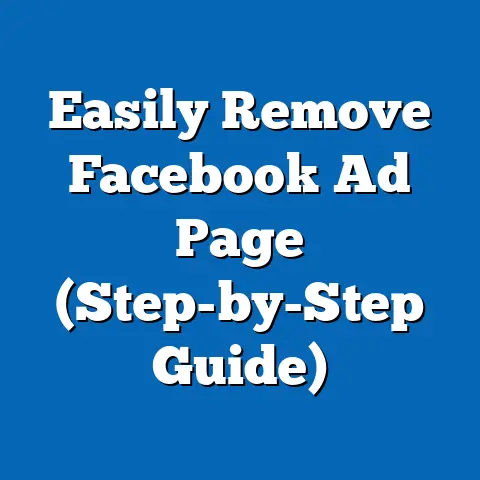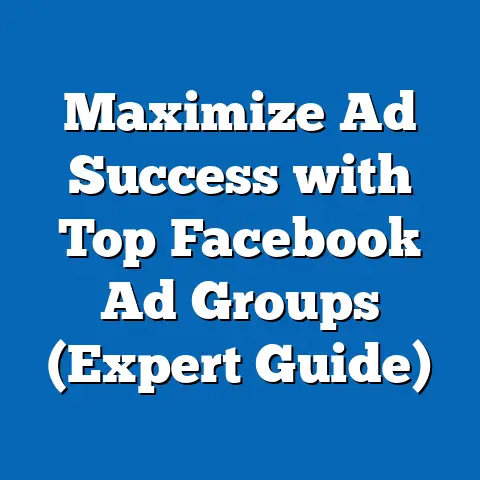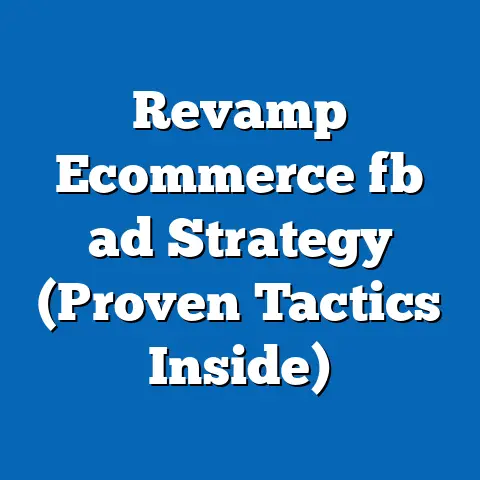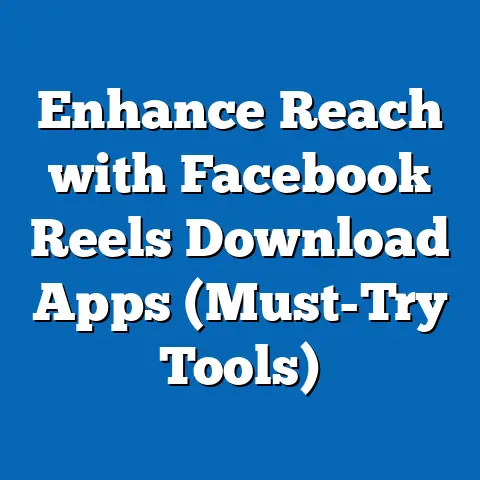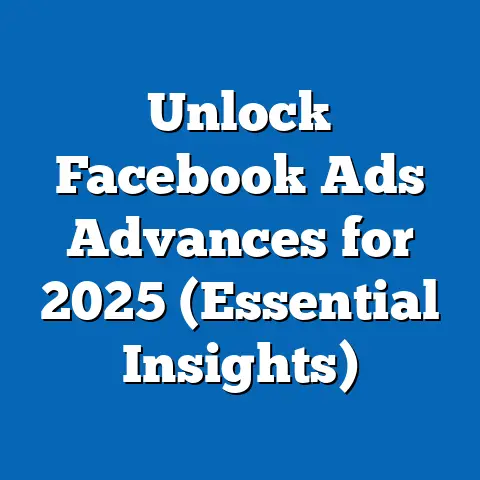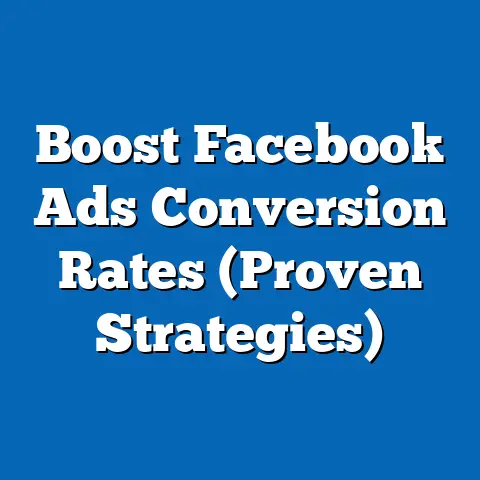Maximize Instapage for Facebook Ads Success (Pro Tips Revealed)
Have you ever felt like you’re throwing money into a black hole with your Facebook Ads? You meticulously craft your ad, target the perfect audience, but the conversions just aren’t there. You’re not alone! Many businesses struggle to see the ROI they expect from Facebook Ads. The problem often isn’t the ad itself, but what happens after the click. This is where the magic of a dedicated landing page comes in.
Expert Tip: I’ve seen firsthand how using a dedicated landing page, especially one built with a powerful tool like Instapage, can skyrocket conversion rates. In fact, I worked with a client in the e-commerce space who was sending Facebook Ad traffic directly to their product pages. Their conversion rate was a dismal 0.8%. After building dedicated, campaign-specific landing pages in Instapage, complete with tailored messaging and clear call-to-actions, their conversion rate jumped to 4.5% – a massive increase! This wasn’t just luck; it was the power of a focused, optimized landing page experience.
In this article, I’m going to reveal the pro tips and strategies you need to maximize Instapage for your Facebook Ads. We’ll go beyond the basics and dive deep into how to create high-converting landing pages that turn clicks into customers. Get ready to unlock the true potential of your Facebook advertising!
Understanding Facebook Ads and Their Importance
Let’s be honest, Facebook has become an advertising behemoth. With billions of active users, it’s a platform no serious business can afford to ignore. But simply throwing ads out there and hoping for the best is a recipe for disaster. To truly succeed, you need to understand the platform’s power and how to leverage it effectively.
Overview of Facebook Ads
Facebook boasts a staggering user base, offering unparalleled reach for advertisers. As of Q4 2023, Facebook had approximately 3.07 billion monthly active users (MAUs). That’s nearly half the world’s population! This massive audience provides a diverse range of demographics, interests, and behaviors that you can target with laser precision.
Beyond sheer numbers, Facebook also offers incredible engagement opportunities. Users spend a significant amount of time on the platform, interacting with content, connecting with friends, and discovering new products and services. According to Statista, the average daily time spent on Facebook by users worldwide is around 30 minutes. This presents a prime opportunity for businesses to capture attention and drive meaningful interactions.
Why Use Facebook Ads
So, why choose Facebook Ads over other advertising channels? Here are a few compelling reasons:
- Granular Targeting: Facebook’s targeting capabilities are unmatched. You can target users based on demographics (age, gender, location), interests, behaviors, connections, and even custom audiences based on your own customer data. This allows you to reach the right people with the right message at the right time.
- Cost-Effectiveness: Compared to traditional advertising methods like TV or print, Facebook Ads can be incredibly cost-effective. You have complete control over your budget and can set daily or lifetime spending limits. You can also choose from various bidding strategies to optimize your ad spend for maximum ROI.
- Measurable Results: Facebook provides detailed analytics and reporting tools that allow you to track the performance of your ads in real-time. You can see how many people saw your ad, how many clicked on it, and how many converted into customers. This data allows you to make informed decisions and optimize your campaigns for better results.
- Variety of Ad Formats: Facebook offers a wide range of ad formats to suit different marketing goals, including image ads, video ads, carousel ads, collection ads, and lead generation ads. This allows you to create engaging and visually appealing ads that capture attention and drive action.
- Retargeting Capabilities: Facebook’s retargeting capabilities are incredibly powerful. You can retarget users who have previously interacted with your website, app, or Facebook page with personalized ads. This helps you stay top-of-mind and drive conversions from users who have already shown interest in your brand.
Role of Landing Pages in Facebook Ads
Imagine driving potential customers to your website through engaging Facebook ads, only to have them bounce because the landing page is irrelevant or confusing. A dedicated landing page acts as a crucial bridge between your ad and a successful conversion. It’s where you deliver on the promise of your ad and guide users towards taking the desired action, whether it’s signing up for a newsletter, requesting a demo, or making a purchase.
Think of it this way: your Facebook Ad is the bait, and your landing page is the hook. A well-designed and optimized landing page can significantly increase your conversion rates and maximize the ROI of your Facebook Ads campaigns. A disjointed experience, on the other hand, can lead to wasted ad spend and missed opportunities.
Key takeaway: Facebook Ads are a powerful tool for reaching a vast audience and driving traffic to your website. However, without a dedicated and optimized landing page, you’re likely leaving money on the table. The landing page is where the conversion happens, so it’s crucial to make it as relevant, engaging, and user-friendly as possible.
Introduction to Instapage
Now that we understand the importance of Facebook Ads and the critical role of landing pages, let’s dive into Instapage. This powerful landing page builder is a game-changer for marketers looking to create high-converting experiences and maximize their ROI.
What is Instapage?
Instapage is a leading landing page platform designed to help businesses create, personalize, and optimize post-click experiences. Unlike traditional website builders, Instapage is specifically focused on landing pages, offering a range of features and tools tailored to conversion optimization.
Here’s what sets Instapage apart:
- Dedicated Landing Page Focus: Instapage is built solely for creating landing pages, meaning it offers a more streamlined and focused experience than general website builders.
- Advanced Personalization: Instapage allows you to personalize landing page content based on various factors, such as ad campaign, audience segment, and user behavior. This allows you to create highly relevant and targeted experiences that resonate with your audience.
- A/B Testing Capabilities: Instapage offers robust A/B testing capabilities that allow you to test different landing page variations and identify the most effective elements. This helps you continuously optimize your landing pages for maximum conversion rates.
- Integration with Marketing Tools: Instapage seamlessly integrates with a wide range of marketing tools, including Facebook Ads, CRM systems, email marketing platforms, and analytics platforms. This allows you to streamline your workflow and track the performance of your landing pages across your entire marketing ecosystem.
- Collaboration Features: Instapage offers collaboration features that allow teams to work together on landing page projects. This helps streamline the development process and ensure that everyone is on the same page.
User Experience and Interface
One of the biggest advantages of Instapage is its user-friendly interface. The platform features a drag-and-drop editor that makes it easy to create and customize landing pages without any coding knowledge.
Here’s what you can expect from the Instapage interface:
- Drag-and-Drop Editor: The drag-and-drop editor allows you to easily add, move, and resize elements on your landing page. This makes it easy to create visually appealing and engaging designs without any coding skills.
- Customizable Templates: Instapage offers a wide range of customizable templates that you can use as a starting point for your landing pages. These templates are designed for various industries and use cases, making it easy to find one that suits your needs.
- Intuitive Design Tools: Instapage provides a range of intuitive design tools that allow you to customize the look and feel of your landing pages. You can easily change colors, fonts, images, and other design elements to match your brand.
- Mobile-Responsive Design: Instapage automatically optimizes your landing pages for mobile devices, ensuring that they look great and function flawlessly on any screen size.
- Real-Time Preview: Instapage allows you to preview your landing pages in real-time as you make changes. This helps you ensure that your landing pages look exactly the way you want them to before you publish them.
Integrations
Instapage’s integration capabilities are a major selling point. It seamlessly connects with the tools you already use, streamlining your workflow and maximizing efficiency. Here are some key integrations:
- Facebook Ads: Direct integration with Facebook Ads allows you to easily track the performance of your landing pages and optimize your campaigns for better results. You can also use Facebook Pixel to track user interactions and retarget users who have visited your landing pages.
- CRM Systems: Integration with CRM systems like Salesforce, HubSpot, and Marketo allows you to automatically capture leads and sync data between your landing pages and your CRM. This helps you streamline your lead management process and ensure that your sales team has the information they need to close deals.
- Email Marketing Platforms: Integration with email marketing platforms like Mailchimp, AWeber, and Constant Contact allows you to automatically add leads to your email lists and send them targeted email campaigns. This helps you nurture leads and drive conversions.
- Analytics Platforms: Integration with analytics platforms like Google Analytics allows you to track the performance of your landing pages and gain insights into user behavior. This helps you identify areas for improvement and optimize your landing pages for better results.
Key takeaway: Instapage is a powerful and user-friendly landing page platform that can significantly improve the performance of your Facebook Ads campaigns. Its drag-and-drop editor, customizable templates, and integration with marketing tools make it easy to create high-converting landing pages that drive results.
Pro Tips for Maximizing Instapage with Facebook Ads
Now, let’s get to the heart of the matter: how to actually use Instapage to supercharge your Facebook Ads. These aren’t just generic tips; they’re battle-tested strategies I’ve used and refined over years of running Facebook Ads campaigns.
Tip 1: Create Tailored Landing Pages for Each Campaign
The biggest mistake I see marketers make is sending all their Facebook Ad traffic to the same generic landing page or, even worse, their homepage. This is a conversion killer! Your landing page needs to be directly relevant to the ad that the user clicked on.
Importance of relevance and personalization:
Relevance is key to capturing and maintaining a user’s attention. When someone clicks on your ad, they expect to see a landing page that delivers on the promise of that ad. If the landing page is irrelevant or confusing, they’re likely to bounce. Personalization takes it a step further by tailoring the landing page content to the specific user or audience segment. This can include things like using their name, referencing their location, or showcasing products or services that are relevant to their interests.
Step-by-step guide on how to tailor landing pages in Instapage:
- Identify Your Campaign Goals: Before you start building your landing page, clearly define the goal of your Facebook Ads campaign. What action do you want users to take? (e.g., sign up for a newsletter, request a demo, make a purchase)
- Match Your Messaging: Ensure that the headline, subheadline, and body copy on your landing page directly reflect the messaging in your Facebook Ad. Use the same keywords and phrases to create a seamless experience.
- Customize Your Visuals: Use images and videos that are relevant to your ad and your target audience. High-quality visuals can significantly increase engagement and conversion rates.
- Create Dedicated Landing Pages: Don’t send traffic to your homepage or a generic product page. Create a dedicated landing page specifically for each Facebook Ads campaign.
- Use Dynamic Text Replacement (DTR): Instapage offers a feature called Dynamic Text Replacement (DTR) that allows you to automatically insert keywords from your Facebook Ads into your landing page copy. This helps create a highly personalized and relevant experience for each user.
Example: Let’s say you’re running a Facebook Ad campaign promoting a discount on running shoes. Your ad should clearly mention the discount and feature images of running shoes. When users click on the ad, they should be taken to a landing page that prominently displays the discount and showcases a selection of running shoes. The headline on the landing page might read something like “Get 20% Off Running Shoes!”
Tip 2: A/B Testing for Optimization
A/B testing, also known as split testing, is the process of comparing two versions of a landing page to see which one performs better. It’s a crucial step in optimizing your landing pages for maximum conversion rates.
Explain the concept of A/B testing and its significance:
A/B testing allows you to make data-driven decisions about your landing page design and content. Instead of relying on guesswork or gut feeling, you can test different elements and see which ones resonate best with your audience. This helps you identify areas for improvement and continuously optimize your landing pages for better results.
Provide a detailed process for setting up A/B tests using Instapage:
- Identify Elements to Test: Start by identifying the elements on your landing page that you want to test. This could include things like the headline, subheadline, call-to-action button, images, or form fields.
- Create Variations: Create two or more variations of your landing page, each with a different version of the element you’re testing. For example, you might test two different headlines or two different call-to-action button colors.
- Set Up A/B Test in Instapage: In Instapage, go to the “A/B Testing” tab and create a new A/B test. Choose the landing page you want to test and select the variations you created.
- Define Your Goals: Define the goals you want to track for your A/B test. This could include things like conversion rate, click-through rate, or time on page.
- Run Your Test: Run your A/B test for a sufficient amount of time to gather enough data to make statistically significant conclusions.
- Analyze Results: Once your A/B test is complete, analyze the results to see which variation performed better. Use the data to make informed decisions about your landing page design and content.
Example: You might want to test two different headlines on your landing page:
- Version A: “Get a Free Ebook on Facebook Ads”
- Version B: “Learn the Secrets to Facebook Ads Success”
Run the A/B test and see which headline generates more sign-ups.
Tip 3: Leveraging Analytics
You can’t improve what you don’t measure. Tracking performance metrics is absolutely essential for optimizing your Instapage landing pages and maximizing your Facebook Ads ROI.
Discuss the importance of tracking performance metrics:
Tracking performance metrics allows you to see how your landing pages are performing and identify areas for improvement. This data helps you make informed decisions about your landing page design and content and optimize your campaigns for better results.
Guide readers on how to use Instapage’s built-in analytics tools:
- Access the Analytics Dashboard: In Instapage, go to the “Analytics” tab to access the analytics dashboard.
- Track Key Metrics: Track key metrics such as conversion rate, click-through rate, bounce rate, time on page, and cost per acquisition.
- Segment Your Data: Segment your data by different factors, such as ad campaign, audience segment, and device type. This helps you identify trends and patterns in your data.
- Use Heatmaps: Instapage offers heatmaps that allow you to see where users are clicking and scrolling on your landing pages. This helps you identify areas of interest and optimize your design for better engagement.
- Integrate with Google Analytics: Integrate your Instapage account with Google Analytics to track more detailed data about user behavior on your landing pages.
Example: You might notice that your landing page has a high bounce rate on mobile devices. This could indicate that your landing page is not optimized for mobile or that your mobile users are not finding what they’re looking for. Use this data to make improvements to your mobile landing page design or targeting.
Tip 4: Seamless Integration with Facebook Pixel
The Facebook Pixel is a snippet of code that you place on your website to track user actions. It’s an invaluable tool for retargeting and optimizing your Facebook Ads campaigns.
Explain the role of Facebook Pixel in tracking user interactions:
The Facebook Pixel allows you to track a wide range of user actions on your website, including page views, button clicks, form submissions, and purchases. This data helps you understand how users are interacting with your landing pages and optimize your campaigns for better results.
Provide a step-by-step guide on how to integrate Facebook Pixel with Instapage:
- Create a Facebook Pixel: In Facebook Ads Manager, create a new Facebook Pixel.
- Copy the Pixel Code: Copy the pixel code from Facebook Ads Manager.
- Add the Pixel Code to Instapage: In Instapage, go to the “Settings” tab and paste the pixel code into the “Head Code” section.
- Verify the Pixel: Use the Facebook Pixel Helper Chrome extension to verify that the pixel is firing correctly on your landing pages.
Example: You can use the Facebook Pixel to retarget users who have visited your landing page but haven’t yet signed up for your newsletter. Show them a personalized ad reminding them of the benefits of signing up and offer them a special incentive.
Tip 5: Mobile Optimization
In today’s mobile-first world, optimizing your landing pages for mobile devices is no longer optional – it’s essential. A significant portion of Facebook users access the platform on their mobile devices, so you need to ensure that your landing pages look great and function flawlessly on any screen size.
Discuss the increasing importance of mobile users in Facebook advertising:
Mobile users are a significant and growing segment of the Facebook audience. According to Facebook, the majority of its users access the platform on mobile devices. This means that you need to optimize your landing pages for mobile to reach the widest possible audience and maximize your conversion rates.
Share best practices for ensuring landing pages are mobile-responsive using Instapage:
- Use Mobile-Responsive Templates: Instapage offers a wide range of mobile-responsive templates that automatically adapt to different screen sizes. Use these templates as a starting point for your mobile landing pages.
- Optimize Images: Optimize your images for mobile devices by reducing their file size and using responsive image formats. This will help your landing pages load faster on mobile devices.
- Use a Clear and Concise Design: Use a clear and concise design that is easy to navigate on mobile devices. Avoid clutter and focus on the most important information.
- Use Large Buttons and Links: Use large buttons and links that are easy to tap on mobile devices.
- Test on Different Devices: Test your landing pages on different mobile devices to ensure that they look great and function flawlessly on all screen sizes.
Example: Use a single-column layout, large font sizes, and prominent call-to-action buttons to make your mobile landing pages easy to use and navigate.
Tip 6: Utilizing Instapage’s Collaboration Features
Landing page creation is often a team effort. Instapage’s collaboration features make it easy for teams to work together on projects, share feedback, and streamline the development process.
Describe how teams can work together using Instapage’s collaboration tools:
Instapage offers a range of collaboration tools that allow teams to work together on landing page projects. These tools include:
- User Roles and Permissions: Assign different roles and permissions to team members to control who can access and edit your landing pages.
- Real-Time Collaboration: Collaborate with team members in real-time on the same landing page.
- Comments and Feedback: Leave comments and feedback directly on the landing page to provide context and guidance.
- Version History: Track changes to your landing pages and revert to previous versions if needed.
Include tips on how to streamline the development process and gather feedback efficiently:
- Define Roles and Responsibilities: Clearly define the roles and responsibilities of each team member involved in the landing page development process.
- Use a Project Management Tool: Use a project management tool to track tasks, deadlines, and progress.
- Establish a Feedback Process: Establish a clear feedback process to ensure that everyone has the opportunity to provide input and suggestions.
- Use Instapage’s Collaboration Features: Use Instapage’s collaboration features to streamline the development process and gather feedback efficiently.
Key Takeaway: These pro tips are designed to help you unlock the full potential of Instapage and maximize the ROI of your Facebook Ads campaigns. By tailoring your landing pages, A/B testing different elements, leveraging analytics, integrating with Facebook Pixel, optimizing for mobile, and utilizing collaboration features, you can create high-converting experiences that drive results.
Case Studies and Success Stories
Theory is great, but seeing real-world results is even better. Let’s take a look at some examples of businesses that have successfully used Instapage in their Facebook Ads campaigns.
Highlight Success Stories
- Lead Generation for a SaaS Company: A software-as-a-service (SaaS) company used Instapage to create a dedicated landing page for their Facebook Ads campaign promoting a free trial of their software. By tailoring the landing page to the specific ad campaign and using a clear call-to-action, they were able to increase their lead generation by 40%.
- E-commerce Sales for a Retailer: An online retailer used Instapage to create a dedicated landing page for their Facebook Ads campaign promoting a sale on summer clothing. By showcasing the sale items on the landing page and using a visually appealing design, they were able to increase their e-commerce sales by 25%.
- Event Registration for a Conference: A conference organizer used Instapage to create a dedicated landing page for their Facebook Ads campaign promoting their upcoming conference. By highlighting the key speakers, topics, and benefits of attending the conference, they were able to increase their event registration by 30%.
Analysis of Results
These success stories highlight the power of using Instapage in conjunction with Facebook Ads. By tailoring their landing pages to the specific ad campaigns, using clear calls-to-action, and optimizing their designs for conversion, these businesses were able to achieve significant results.
Metrics like conversion rates and ROI saw notable improvements:
- Increased lead generation by 40%
- Increased e-commerce sales by 25%
- Increased event registration by 30%
These results demonstrate that using Instapage can be a game-changer for businesses looking to maximize the ROI of their Facebook Ads campaigns.
Key Takeaway: These case studies demonstrate the real-world impact of using Instapage with Facebook Ads. By focusing on relevance, personalization, and optimization, businesses can achieve significant improvements in their conversion rates and ROI.
Conclusion
We’ve covered a lot of ground in this guide, from understanding the importance of Facebook Ads and the role of landing pages to diving deep into the pro tips for maximizing Instapage. Now it’s time to put these strategies into action and start seeing real results.
Recap of Key Points
Let’s recap the key takeaways from this article:
- Dedicated Landing Pages are Crucial: Always use dedicated landing pages for your Facebook Ads campaigns.
- Tailor Your Messaging: Ensure that your landing page messaging is directly relevant to the ad that the user clicked on.
- A/B Test Everything: Continuously A/B test different elements on your landing pages to optimize for conversion.
- Leverage Analytics: Track performance metrics to identify areas for improvement.
- Integrate with Facebook Pixel: Use the Facebook Pixel to track user interactions and retarget users who have visited your landing pages.
- Optimize for Mobile: Ensure that your landing pages are mobile-responsive and look great on all devices.
- Utilize Collaboration Features: Streamline the development process and gather feedback efficiently using Instapage’s collaboration tools.
By following these tips, you can unlock the full potential of Instapage and maximize the ROI of your Facebook Ads campaigns.
Call to Action
Now it’s your turn! Take what you’ve learned in this guide and start implementing these pro tips in your own Facebook Ads campaigns. Don’t be afraid to experiment, test different approaches, and track your results. The key to success is to continuously optimize your landing pages and campaigns based on data.
I challenge you to create at least one dedicated landing page for your next Facebook Ads campaign using Instapage. A/B test two different headlines and see which one performs better. Integrate with Facebook Pixel and track user interactions. Optimize for mobile and test on different devices.
The possibilities are endless. By taking action and implementing these pro tips, you can start seeing real improvements in your conversion rates and ROI.
So, what are you waiting for? Start maximizing Instapage for Facebook Ads success today!

